The Exhibition
The exhibition recalls one of the most critical moments in the history of Palermo: the fifty year time span that sees the city hit by two terrible plagues, in 1575-76 and in 1624; the helpless and decimated population seeks comfort and protection in the traditional Patrons, the five Virgin Saints of Palermo, the Saints Rocco and Sebastiano, to whom is added in those same years Saint Carlo Borromeo, thanks to the cult introduced in the city by the rich merchant “Nation” of the Lombardi. But in 1624, at the outbreak of an even more devastating pestilence, the discovery on Mount Pellegrino of the sacred remains of Rosalia, a Palermo hermit lived in the Middle Ages, and the simultaneous immediate end of the disease, make it possible to attribute to her special thaumaturgical powers, such to acclaim her as the only patron against the terrible disease.
The triumph of the cult, immediately spread throughout Europe and further thanks to the Jesuits and the Franciscans, requires precise choices regarding the iconography of the Saint, to which particular contribution is provided by Anton Van Dyck, the great Flemish painter living in Palermo in that sad period.
Based on these elements, the exhibition develops through a path that, starting from the devotion to the traditional patrons Saints, exemplified by a series of important paintings and sculptures of the sixteenth century made in those years, reaches the triumph of the cult of Rosalia as the only patron, configured by several works, especially altarpieces, commissioned by famous artists such as Anton Van Dyck, Pietro Novelli, Vincenzo La Barbera and Mattia Preti. The paintings and sculptures are joined by numerous preparatory drawings of large paintings, decorative works of art, printed and archival materials.
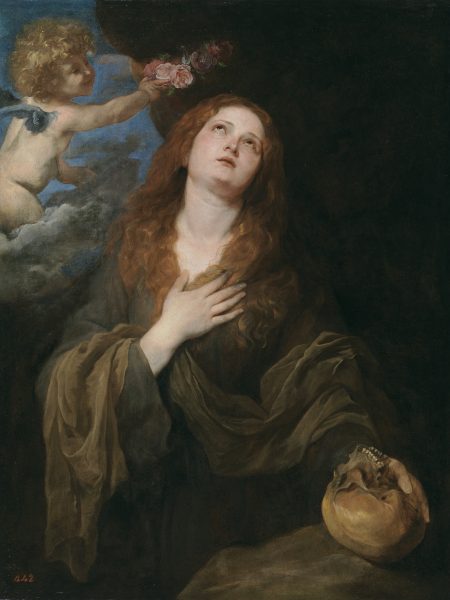
The cult of Saint Rosalia is not exclusive to Sicilian history and traditions. With this exhibition, the Federico II Foundation underlines, after careful and detailed research, that element that sees it go beyond the borders of the island. It is in the relationship with the “Nation” of the Lombards that one of its highest expressions is found. Upper Lombardy, between the fifteenth and nineteenth centuries, was characterized by an emigration process towards the city of Palermo. A flow that developed mainly in the seventeenth century. The result was a collaboration aimed at collecting money offers for the purchase of material goods to be sent to the ecclesial communities of origin. Among the gifts, there are various sacred ornaments in silver, still preserved today in the Lombard churches.
The action promoted by the Federico II Foundation continues, in synergy with the Sicilian Regional Assembly, the Regional Department of Cultural Heritage and Sicilian Identity, the Superintendence for Cultural Heritage and the Archdiocese of Palermo, aimed at protecting the historical artistic heritage, in the strictest sense, to give back our history, our culture, our arts and our knowledge to the whole community, especially to the new generations.
The Location
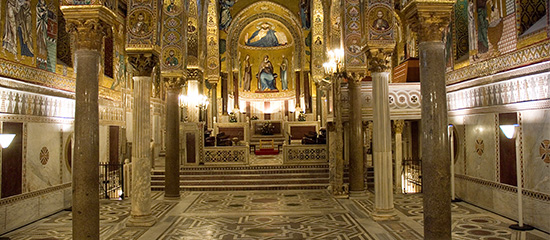
The Royal Palace (Palazzo dei Normanni) is situated in Palermo, and it is the most ancient Royal residence in Europe. Still visible in the dungeons, the remains of the first Punic settlements, but the first structure dates back to the arab domination in the IX century.
The Normans later transformed the Castle into the center of their monarchy and built four towers, connected with porches and gardens. Thanks to Roger II, a magnificent chapel was built inside the palace, the “Palatine Chapel”, dedicated to Saint Peter and Saint Paul and consecrated in 1140. The complex was originally connected to the Cathedral through a covered path. In 1556, after the demolition the towers and the reconstruction of the great façade, it became the residence of the Spanish Viceroys.
The manor was built on two stories: ground floor and noble floor; adjacent to the main building and accessible through designated openings was the chapel; this was decorated with painted architectures created in 1762.
After the Unification of Italy, it became part of the estate of the Military and, with the occasion the national exhibition of 1891 – 1892 the furniture in the royal apartments was renovated. In 1919 the possibility of using the Palace as the location for the academies of the building was proposed by Architect Corrado Anselmi. The exhibition spaces are dedicated to the conservation and presentation to the public of the painting collections and of a selection of graphic artworks.
In the ‘30s of the ‘900, some restorations were made by superintendent to monuments Francesco Valenti, then continued by Mario Guiotto, bringing back some of the Norman structures. Only in 1947 it was named Palazzo dei Normanni (Palace of the Normans) and the associations located there were transferred elsewhere.
The latest restorations took place in 2002, following the damages due to the earthquake. Today the Palace has an important directorial function, as it is the location of the Assemblea Regionale Siciliana (Sicilian Regional Council), but it is also the headquarter of the Astronomic Observatory of Palermo.
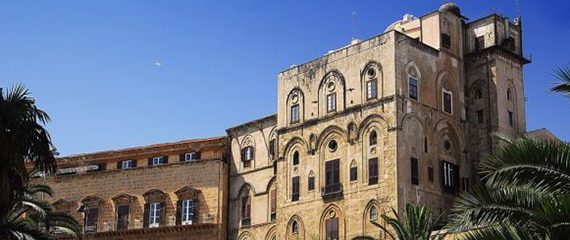
Gallery
INFORMATION
Ingresso da Piazza del Parlamento
Timetable
Monday/Saturday 8.15 a.m. to 5.40 p.m.
(last ticket 4.40 p.m.)
Sundays/Holidays 8.15 a.m. to 1.00 p.m.
(last ticket 12.00 a.m.)
Ticket price
Only Exhibition
full fare € 6,00
Reduced
Teenagers: 14/17 years € 3,00
Students in school visit € 1,00
Only Royal Gardens
Everyday € 2,00
Exhibition, Palatine Chapel and Royal Apartments
from Friday to Monday and holidays when Royal Apartments are open
full fare € 12,00 – reduced € 10,00
Exhibition and Palatine Chapel
from Friday to Monday when the Royal Apartments are closed
full fare € 10,00 – reduced € 8,00
Teachers and young people aged between 18 and 25 years are entitled to reduced ticket.
Reduced Ticket Price everyday
Seniors (>) 65 years € 8,00
Teenagers: 14/17 years € 4,00
Students in school visit € 2,00
It is possible to make a RESERVATION for the exhibition visit and Monumental Complex sending an email to fondazione@federicosecondo.org
(info +39 091 6262833)

An exhibition outside the logic of pre-packaged products
“This exhibition brings out the greatness of Saint Rosalia, able not only to heal the plague victims, but to do another miracle: to unite territories that in other respects are very distant. Devotion to the patron saint even in the upper Padan Plain is an irrefutable message of high relevance. And if the devotion to Santa Rosalia from South to North is the proof and the hope that religion will unite, even art once again creates unimaginable links beyond geographical boundaries and divisions. This exhibition also has the merit of being an absolute first. The Federico II Foundation continues to reject pre-packaged exhibitions, coming out of the logic of the such product. These are unique exhibitions, built for the occasion with a lot of work and inter-institutional collaboration with the intention, not easy but certainly ambitious, to generate a cultural process, which in this case concerns our beloved patron saint. But there’s more, Rosalia has returned home through the main entrance. The inauguration of the exhibition at the Royal Palace, where Rosalia Sinibaldi lived, coincides with the opening, after a long time, of the Seventeenth-century Regimental Gateway Door, which gives way to the new tourist route of one of the most visited sites in Sicily and of vertiginous growth. The visitors, until now entering through a side entrance, can finally access from Piazza Parlamento, located in the heart of the Unesco Heritage Norman-Arab route. To welcome the exhibition, a votive shrine that will remain inside the building, but also “R”, the show dedicated to her that has thrilled me and has won the approval of the public and critics “.
Gianfranco Miccichè
President of the Sicilian Regional Assembly and the Federico II Foundation
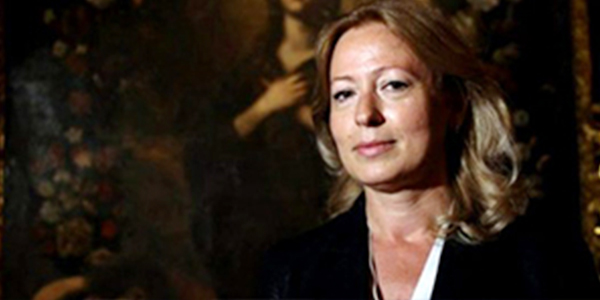
Rosalia, a female and international Saint
“In a historical-political moment in which our glorious constitution is insistently put under scrutiny, we should, as a beacon, keep in mind the basis of Article 9 that promotes the development of culture and scientific research and the protection of heritage. Precisely due to this last point the Federico II Foundation has chosen to invest resources and energy by channeling them into the exhibition “Sicilië, Flemish painting” and now in “ROSALIA eris in peste patrona”. The cement of all this work lies in cultural cooperation and in the valorization of the Cultural Heritage in synergy with the other Institutions present on Italian and foreign territories. A passage that, in the past years, has been neglected. It is undoubtly easier to avoid the effort of the campaign to borrow paintings and sculptures scattered in the territories. We have already been against the current for the exhibition “Sicilië, Flemish painting” and now for “Rosalia eris in peste patrona”. We have reversed the route. Ours is a more difficult work method, complex but of profound transformation and extraordinary results. So much effort and so much energy engaged in research and study have given us a surprise: to discover how much the magnificence of the works regarding the Saint and her devotion is not an exclusive fact of Sicilian history and traditions. This exhibition, in fact, highlights, after careful and detailed research, that element that sees it go beyond the borders of the island. A miracle, the one from the liberation from the plague, carried out in the Sicilian capital that went around the world: affected by the plague in the Seventeenth century, the citizens of São Paulo in Brasil, of Caracas in Venezuela, of Monterey in California were entrusted to the Saint. A popularity that has never had borders especially thanks to, more than other artists, Anton Van Dyck; contributing in this way to spread the cult of an international saint. The one for Saint Rosalia is a cult rooted in the territory that ends up conquering such a communicative force capable, over the centuries, of delineating a strongly diffusive trait. The patron saint of Palermo contains in herself a high symbolic, significant and foundational value of a certain religiosity that, going beyond tradition, enhances the ascetic dimension while maintaining, at the same time, a concrete role towards citizenship. Reclaiming the figure of Saint Rosalia is an urgency to stimulate research and the Federico II Foundation is responsible for its paternity, including the historical and cultural roots of the Royal Palace”.
Patrizia Monterosso
General Manager of the Federico II Foundation
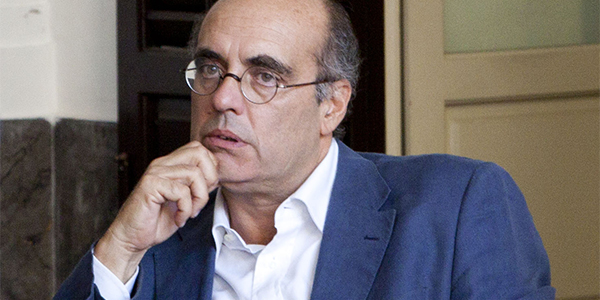
A rigorous and faithful historical reconstruction
“Rosalia Sinibaldi, a noble Palermitan girl of the Twelfth century, probably of Norman origin, become in the Seventeenth century the patron saint of Palermo, returns to live in the halls of the Royal Palace, home of her youth, according to the legendary biography between myth and history. To the Virgin hermit who saved the Sicilian capital from the plague is dedicated in fact the great exhibition, curated by Vincenzo Abbate, which will be inaugurated on September 4th, on the day of thediesnatalis (birthday) of the Saint, right in the halls of the Duke of Montalto of the Royal Palace. Precious synergy between the Department of Cultural Heritage and Sicilian Identity of the Sicilian Region and the Federico II Foundation in this original and unprecedented initiative that gives back to the public an articulated and complex reading path aimed at combining the past and the present in a multiplicity of expressive registers. The intent is that of a rigorous historical reconstruction in order to retrace, starting from the plague of the Seventeenth century, the most significant stages of a centuries-old cult which becomes a symbol of the municipality and of the urban renaissance by the Jesuits. The extraordinary symbolic effectiveness of the PalermitanSantuzza (little saint) is demonstrated by the vast figurative heritage of artists such as Pietro Novelli, Vincenzo La Barbera and Antoon Van Dyck who,during his stay in Palermo, dedicated to the Saint a series of works, now in the Regional Gallery of Palazzo Abatellis of Palermo, at the Metropolitan Museum in New York, in Antwerp, in Vienna, at the Museum of Puerto Rico, but also such as Luca Giordano, whose paintings are exhibited at the Museo del Prado, and Bartolomè Esteban Murillo, at the Thyssen Museum in Madrid, just to name a few the most important. Works not only from Sicily are exhibited to the public in order to show the extraordinary spread of Saint Rosalia, immortalized not only in the great figurative and sculptural works, but also in an infinite variety of devotional objects of everyday life. In the year in which Palermo is proclaimed the capital of culture, this exhibition presents itself as the revival of a myth that is renewed every year with the parade of the triumphal chariot during the July Festino (feast) and the great religious procession of the relics in the silver urn, as well as with the acchianata (pilgrimage) to the sacred Montepellegrino in the month of September, becoming, in the final analysis, the most representative expression of the collective memory, almost a totem of the cultural identity of Palermo “.
Sergio Alessandro
General Manager of the Department of Cultural Heritage and Sicilian Identity
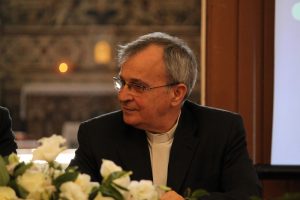
Beyond the ascetic dimension, the concrete link with the people
“The devotion to Saint Rosalia has a strongly communicative character and proof of it are the rapid timing of her canonization and of her acclamation as the patron saint of Palermo. The recognition as a protector of the city is conferred to Rosalia almost by right, considered the grave and tragic historical context in which the plague decimated the people starting from 1624. The merit is attributable to the Genoese Archbishop GiannettinoDoria, who managed to establish a close link between the discovery of the female bones in the cave on Mount Pellegrino and the end of the black plague epidemic following the procession of the urn with the mortal remains of the Santuzza (little saint). In 1625 Rosalia was proclaimed patron of Palermo by the city Senate and by popular acclamation, immediately becoming the point of reference for the whole city and forever obscuring the role of the four ancient copatron saints: Ninfa, Olive, Agatha and Cristine. In 1630, thanks to the popularity achieved by the “Santuzza”, the Doria managed to obtain from Pope Urban VIII, of whom the Cardinal had been one of the great electors, the inclusion of Rosalia in the Roman Martyrology, definitive confirmation of the patron saint’s holiness.
The Santuzza then also assumed a strategic role in the sphere of Spanish politics: Rosalia as a warrior aiding the Catholic king was used as an “instrumentumregni” to eradicate, for example, the Catalan insurgents. In a short time, the cult to the saint became so ingrained and of such great communicative power to acquired over the centuries a markedly diffuse trait. The Palermo Saint who lives in the context of the city is taken as a model to free other places from the plague. We find in Rosalia’s devotion a very strong, significant and fundamental symbolic value of a type of religiosity that values the ascetic dimension which, at the same time, maintains a concrete, human bond with the people. Palermo already had a long and secular experience of the social role of enclosed women in the city. In the Monastery of Saint Catherine of Alexandria at the Cassaro lived nuns of noble families who, despite the strict papal enclosure, exerted a great influence on the political and social life of the city. GiannettinoDoria, recognizing the decisive role that the Dominican nuns had assumed in the history and economic and social development of the city, regarding the proclamation of Rosalia as patron of Palermo, donated to the monastery a relic of the saint, almost to seal that the Santuzza (little saint), noble woman, hermit, new patron of the city, from the top of Mount Pellegrino, replaced the role that for centuries had belonged to the noble cloistered nuns of the Monastery of Saint Catherine, located next to the city palace. In the diffusion of the devotion to the Santuzza great importance must also be attributed to the extraordinary iconographic production of the painted, engraved, sculptured images of the saint from 1624. The exhibition “Rosalia eris in pestepatrona”, fruit of the collaboration of the Cultural Heritage Office of the Archdiocese of Palermo with the Regional Department for Cultural Heritage and Sicilian Identity, the Direction of the Federico II Foundation and the Department of Palermo, is an operation of great intuition and cultural depth, expression of a new way of understanding the promotion and use of the cultural heritage. TheSantuzza descends from Mount Pellegrino and returns to the Royal Palace, in what, according to the historical and hagiographic accounts about Rosalia Sinibaldi was her first home. I believe it is an added value that the public institutions, in a courageous way, have chosen not to set up an easy trendy exhibition, creating competition with private structures, but have invested human and economic resources to let the world know what this land has and in doing so they have operated in synergy among all the institutional realities “.
Padre Giuseppe Bucaro
Director of the Cultural Heritage for the Archdioceses of Palermo

Art to understand the deep link that Palermo has with the patron saint
“The cult of Saint Rosalia in Palermo has its roots in a particular relationship of devotion and love with thepatron saint, the result of a simple faith: for centuries, the city had sought a saint who embodied in her own history a popular Christian humanism, humble, generous, but without being able to find it. At the beginning of the Seventeenth century there were six patron saints in Palermo, Ninfa, Fabian and Sebastian, Agatha, Cristine and Rocco who, despite having had an important role in city devotion on several occasions, had not managed to enter the heart of the inhabitants. Even in 1624 the city, afflicted by the umpteenth contagion of plague, turns to its patron saints with a large procession to demand release from the epidemic but without success and, precisely during the procession, on July 15th, Father Pietro Garofalo narrates that people raise the invocation to Saint Rosalia and he himself follows an “internal inspiration” to invoke her, without knowing that on Mount Pellegrino her bones had been found. A few days later, the image of St. Rosalia is paraded and the plague ceases entirely in the city, and the following year the first big celebration in her honor is held. The cult of Saint Rosalia is therefore born from the sensus fidei of the people of Palermo who, recognizing by intuition of faith her holiness, invoke herobtaining evidence and certainty that the Saints “are the true bearers of light within history, because they are men and women of faith, hope and love “(Deus Caritas est, 40). It is the sensus fidei, which isthe personal attitude that believers possess within the ecclesial communion to discern the truth of faith, which allowed to immediately create a link between the saint and the citizens of Palermo, not the result of abstract theological speculations but of authentic popular piety which “manifests a thirst for God that only the simple and the poor can know” (EvangeliInuntiandi, 48). Precisely this link with popular piety has enabled our city to include the Gospel in everyday life, in a dynamic reality constantly recreated by the people and transmitted from generation to generation. As Pope Francis reminds us: “Each portion of the People of God, translating into their lives the gift of God according to their own genius, is evidence of the faith received and enriches it with new expressions that are eloquent. It can be said that “the people continually evangelize themselves”.Here popular piety is an important expression of the spontaneous missionary activity of the People of God. It is a reality in permanent development, where the Holy Spirit is the protagonist “(EvangeliiGaudium, 122). The acchianata(pilgrimage) on Mount Pellegrino, so heartfelt and shared every year, is an eloquent expression of this faith of the heart, able to entrust itself with simplicity and authenticity to the Lord who welcomes everyone, but also evidence of faith that becomes a missionary announcement in a world that seems increasingly distant and distracted. On the journey to the Shrine everybeliever experiences our Christian life made up of jagged realities, trials and obstacles to overcome but also of sharing, witness, fraternity and certainty of the goal to be reached. Upon arrival, the grotto allows the pilgrim to perceive and make his own the strength of a trusting prayer to God, capable of defeating evil by succeeding in illuminating even the dark depths of the earth. The many ex-votos present in the Shrine are the attestation of how the Lord does not tire of listening to the trusting prayer of his believers and for the intercession of Saint Rosalia continues to perform signs and wonders in the midst of his people freeing them from evil in a renewed Easter experience. In this way all Christians “are made capable of understanding, living and proclaiming the truths of divine revelation” (Lumen Gentium, 35). The iconography, which for centuries has continued to nourish and give life to this faith of the people and which finds admirable synthesis in the present exhibition, helps us grasp the deep bond that Palermo has with its patron saint, but above all it offers us a precious opportunity to rediscover our faith not only in its personal dimension but above all in its ecclesial and community dimension. In this sense the popular dimension of faith becomes an expression of its catholicity, capable of overcoming conflicts through a culture of encounter and solidarity that does not eliminate differences but harmonizes them. May our beloved city still be enriched and sustained by the fruitful faith of its people “.
Corrado Lorefice
Archbishop of Palermo
The image of the Saint and a lively debate on her iconography
“The artistic narration regarding Saint Rosalia and her cult could not avoid including some considerations on the plague and the causes that decimated entire populations of Europe. We have, first of all, chosen to do so through the treaties of the time and the distressing images of death or the heartfelt penitential processions, as they have been represented in the devout paintings of the Fifth and Seventeenth century, in those altarpieces, true ex-votos made for the long-awaited grace obtained through the tutelary Saints. The exhibition develops along a path that, starting fromsculptures and paintingsas concrete testimony of the vast cult still centered in the sixteenth century around the canonical thaumaturge saints against the plague, arrives to Rosalia in the twenties of the seventeenth century. It is Rosalia Sinibaldi who by divine will was proclaimed the only savior thanks to her heartfelt intercession with the celestial Throne which, according to the beautiful invention of Pietro Novelli, the greatest Sicilian painter of the Seventeenth century, in the stunning dedicatory altarpiece of Castiglione delleStiviere officially grants the title: ERIS IN PESTE PATRONA. A conversation on the plague could not avoid the presence of significant works in the exhibition, useful to let the visitor into the life of particular situations and events of those terrible years: as the view of the Cala, the ancient port of the city, always the first and immediate place for the contagion due to the continuous landing of often infectedgalleys and tartansof various origins; but also a crowded penitential procession to obtain the divine grace (and the choice could not fail to fall on the one depicted in the ex-voto panel by Simone di Wobreck, held on the night of July 29th 1576 with the participation of the Duke of Terranova, President of the Kingdom, of the dignitaries, of the clergy and of all the confraternities following the venerated Crucifix of the Cathedral); anda great processional cross, the Cross that normally in moments of felt contrition and repentance from sins becomes a symbol and unequivocal beacon of salvation and redemption. This exhibition also boasts, for the first time, the presence of the great processional cross of Livo (Como), a masterpiece of the 16th century Palermitan silverware, commissioned to the local consulate of the silversmiths by the flourishing and rich Lombard community of Alto Lario resident in the city.The image of Saint Rosalia in the early days, precisely because it concerns the new unique patron of the city, is characterized by a lively debate on her iconography, certainly not easy to solve, if that of a simple hermit and anchorite dressed in rough tunic, assupported by the Franciscan pauperism movements, or of a nun with a noble appearance under the strict rule of a claustral order, as especially the Jesuits and Benedictines claimed on the trail of ancient depictions existing in their illustrious city monasteries”.
Vincenzo Abbate
Art Historian and Museology expert
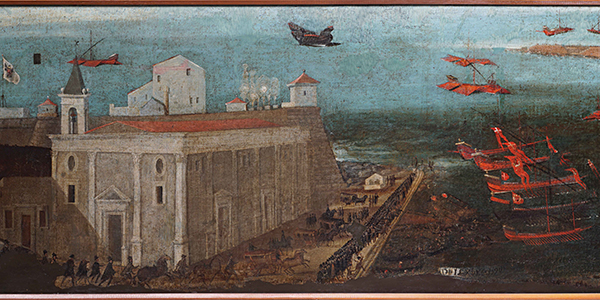
Exemplary pictorial and plastics of the highest importance exhibited
“The exhibition pays tribute to the venerable Saint patron of the city of Palermo, the so-called Santuzza (little saint), retracing, through extremely precious artistic evidence, a crucial historical phase of the city, when at the end of the Sixteenth century the population was periodically decimated by devastating plague epidemics. The first was already in 1575, followed by years of famine and drought in which the defenseless citizens of Palermo sought comfort and protection in the traditional patron saints, the five Holy Virgins of Palermo, the Saints Rocco and Sebastian, who was soon joined by Saint Carlo Borromeo, thanks to the cult introduced into the city by the rich merchant nation of the Lombards. In fact, visitors are welcomed in the exhibition by pictorial and plastic reliefs bearing well-known depictions of the so-called “Saints of the plague”, together with the unprecedented presence of a silver cross from the late sixteenth century embellished with enamels coming from Livo, in the Como area, origin of a large community of Lombards transplanted to Palermo who commissioned it to skilled local workers. In 1624, at the outbreak of an even more devastating pestilence, the discovery of the sacred remains on Mount Pellegrino of Rosalia, a young noblewoman who lived in Norman times, and the simultaneous immediate termination of the disease, attributes her special thaumaturgical powers, and therefore people acclaim her almost immediately as the patron saint of the city.
The triumph of the cult immediately imposes precise choices on the iconography of the Saint, to whom Anton Van Dyck, the great Flemish painter called in Palermo in those sad moments by the viceroy Emanuele Filiberto of Savoy, solemnly codifying the image of the saint in the renowned altarpiece created for the altar of the Oratory of the Rosary of Saint Dominic.
The exhibition then unfolds through a coherent path marked by significant works, especially altarpieces, specifically requested to renowned painters, such as Anton Van Dyck, Vincenzo La Barbera and Pietro Novelli, from Monreale, artist who will contribute the most to the diffusion of the cult of the Saint even outside the island. Novelli’s autographs are in fact present in Sicily for the first time two impressive altarpieces, one from Livo, the other from Castiglione delle Stiviere in Mantua where, even with the necessary differences, the same iconography of the Saint can be seen as she intercedes with the Trinity. Also documenting the fervent devotion to the Saint are the magnificent paintings of the Calabrian Mattia Preti coming from the Museum of Capodimonte and from Malta, also for the first time exhibited in Sicily. Specifically, two important preparatory sketches for frescoes that had to decorate the entrance doors to the city of Naples, show, in a naturalistic setting of great impact, the Saint of Palermo together with Gennaro and other saints, invoked by the Neapolitan citizens against the plague that afflicted the city in 1656, together with the renowned altarpiece of the so-called Madonna di Costantinopoli, originally placed in the church of Sant’Agostino degli Scalzi. The Saint Rosalia in Franciscan clothes housed in the Jesuit church of Sarria in Malta, dating back to the seventies of the Seventeenth century, part of a series of paintings in the same church dedicated to the patron saints of the plague, documents the excellent performance of the Calabrian lord, who resided in Malta until the end of his days. The itinerary ends with an important canvas, probably coming from Sicily and never exhibited in Palermo, kept at the Duca d’Alba Foundation in Seville, depicting a solemn and articulated procession with the urn of the patron saint, through a bird view from which the urban layout and the various monuments of the city are revealed, between the end of the Seventeenth century and the first years of the following century “.
Maddalena De Luca
Valorization Service of the Department of Cultural Heritage and Sicilian Identity
The works reinforce the link between the figure of the young saint and the natural environment
“The image of Saint Rosalia elaborated by the painters of the Seventeenth century naturalism often shows peculiar characteristics that are identified in the almost adolescent features of the patron saint, animated, at least as far as painting is concerned, by a delicate chiaroscuro that softly focuses on the neck and the ecstatic face and which the light diversifies in extremely natural ways. These characteristics that make the image of the Saint extremely timely, human and almost quotidian, are also found in the plastic works, among which the refined silver reliquary statue from the Chiesa Matrice (main church) of Caccamo stands out.
And again, how can we forget that the image of Santa Rosalia appears to be related to some symbolic places of the city of Palermo: the urban center surrounded by walls with all the lush nature of the Conca d’Oro(Golden plain) and on the other Mount Pellegrino, almost a symbol of the city to which the presence of Saint Rosalia attributes an extraordinary religious value. Here Rosalia lived and here her miraculous mortal remains were found; in this way the holy patron turns to the sacred mountain, in the pictorial expressions on display, invoking the protection and divine benevolence in favor of the whole city. It is clear from the above that the works of art elaborated by the great Seventeenth century painters and selected for the exhibition make the correlation between the figure of the young saint and the natural environment rich and vivid “.
Gaetano Bongiovanni
Official of the Department of Cultural Heritage of Palermo
For all texts courtesy translation Elettra La Duca